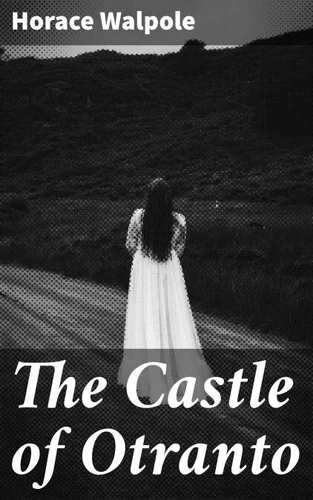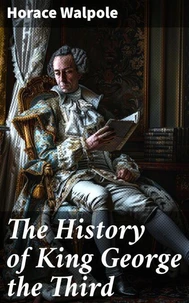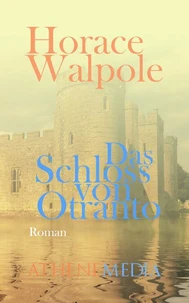The Castle of Otranto. Exploring the supernatural and melodramatic in early Gothic fiction
Par : ,Formats :
Disponible dans votre compte client Decitre ou Furet du Nord dès validation de votre commande. Le format ePub est :
- Compatible avec une lecture sur My Vivlio (smartphone, tablette, ordinateur)
- Compatible avec une lecture sur liseuses Vivlio
- Pour les liseuses autres que Vivlio, vous devez utiliser le logiciel Adobe Digital Edition. Non compatible avec la lecture sur les liseuses Kindle, Remarkable et Sony
 , qui est-ce ?
, qui est-ce ?Notre partenaire de plateforme de lecture numérique où vous retrouverez l'ensemble de vos ebooks gratuitement
Pour en savoir plus sur nos ebooks, consultez notre aide en ligne ici
- Nombre de pages173
- FormatePub
- ISBN4057664102638
- EAN4057664102638
- Date de parution19/11/2019
- Protection num.Digital Watermarking
- Taille486 Ko
- Infos supplémentairesepub
- ÉditeurGOOD PRESS
Résumé
In 'The Castle of Otranto', Horace Walpole masterfully intertwines Gothic elements with an intricate plot steeped in mystery and supernatural occurrences. Published in 1764, this pioneering novel is often credited with laying the foundations of the Gothic genre, showcasing a novelistic style that is both ornate and evocative. The turbulent ambiance of decaying castles, spectral apparitions, and doomed love is palpable, weaving together themes of fate and tyranny, while its complex narrative structure challenges conventional storytelling practices of the time.
Walpole, son of a prominent Whig statesman, was deeply influenced by the cultural milieu of 18th-century England, marked by an evolving appreciation for the sublime and the macabre. His extensive travels across Europe, particularly his fascination with medieval architecture and folklore, congregated into 'The Castle of Otranto', revealing his ambition to merge fiction with an exploration of human emotions and historical echoes.
The novel serves as both a reflection of his literary aspirations and an embodiment of the emerging Gothic sensibilities. For readers intrigued by the psychological depth and atmospheric richness of early Gothic literature, Walpole's 'The Castle of Otranto' is indispensable. It not only invites readers into a world of fantastical intrigue but also serves as a critical touchstone for understanding the evolution of fantasy and horror in literature.
Immerse yourself in its haunting narrative and discover the intricate interplay between love and despair in this seminal work.
Walpole, son of a prominent Whig statesman, was deeply influenced by the cultural milieu of 18th-century England, marked by an evolving appreciation for the sublime and the macabre. His extensive travels across Europe, particularly his fascination with medieval architecture and folklore, congregated into 'The Castle of Otranto', revealing his ambition to merge fiction with an exploration of human emotions and historical echoes.
The novel serves as both a reflection of his literary aspirations and an embodiment of the emerging Gothic sensibilities. For readers intrigued by the psychological depth and atmospheric richness of early Gothic literature, Walpole's 'The Castle of Otranto' is indispensable. It not only invites readers into a world of fantastical intrigue but also serves as a critical touchstone for understanding the evolution of fantasy and horror in literature.
Immerse yourself in its haunting narrative and discover the intricate interplay between love and despair in this seminal work.
In 'The Castle of Otranto', Horace Walpole masterfully intertwines Gothic elements with an intricate plot steeped in mystery and supernatural occurrences. Published in 1764, this pioneering novel is often credited with laying the foundations of the Gothic genre, showcasing a novelistic style that is both ornate and evocative. The turbulent ambiance of decaying castles, spectral apparitions, and doomed love is palpable, weaving together themes of fate and tyranny, while its complex narrative structure challenges conventional storytelling practices of the time.
Walpole, son of a prominent Whig statesman, was deeply influenced by the cultural milieu of 18th-century England, marked by an evolving appreciation for the sublime and the macabre. His extensive travels across Europe, particularly his fascination with medieval architecture and folklore, congregated into 'The Castle of Otranto', revealing his ambition to merge fiction with an exploration of human emotions and historical echoes.
The novel serves as both a reflection of his literary aspirations and an embodiment of the emerging Gothic sensibilities. For readers intrigued by the psychological depth and atmospheric richness of early Gothic literature, Walpole's 'The Castle of Otranto' is indispensable. It not only invites readers into a world of fantastical intrigue but also serves as a critical touchstone for understanding the evolution of fantasy and horror in literature.
Immerse yourself in its haunting narrative and discover the intricate interplay between love and despair in this seminal work.
Walpole, son of a prominent Whig statesman, was deeply influenced by the cultural milieu of 18th-century England, marked by an evolving appreciation for the sublime and the macabre. His extensive travels across Europe, particularly his fascination with medieval architecture and folklore, congregated into 'The Castle of Otranto', revealing his ambition to merge fiction with an exploration of human emotions and historical echoes.
The novel serves as both a reflection of his literary aspirations and an embodiment of the emerging Gothic sensibilities. For readers intrigued by the psychological depth and atmospheric richness of early Gothic literature, Walpole's 'The Castle of Otranto' is indispensable. It not only invites readers into a world of fantastical intrigue but also serves as a critical touchstone for understanding the evolution of fantasy and horror in literature.
Immerse yourself in its haunting narrative and discover the intricate interplay between love and despair in this seminal work.








